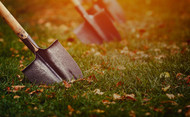In prepping for this post, I did a little informal research and asked some friends and neighbors if they knew the difference between a shovel and a spade. Every one of them said the same thing: spades are the ones with a pointed tip. I used to think the same thing too! I’m guessing the confusion is caused largely by garden spades—which do tend to be pointy—and good old-fashioned playing cards and their classic spiky black spades. The truth is, shovels and spades can both have pointy or flat blades—the real difference is in their intended function. And it’s a pretty big difference!
It's not the front edge that determines whether a tool is a shovel or a spade; it’s the depth of the tool itself—the curve (or lack thereof) of the face of the implement. This greatly affects the way the tool will handle and which jobs it will be suitable for. Put very simply, a shovel is for moving material, while a spade is primarily for cutting soil and digging holes.



